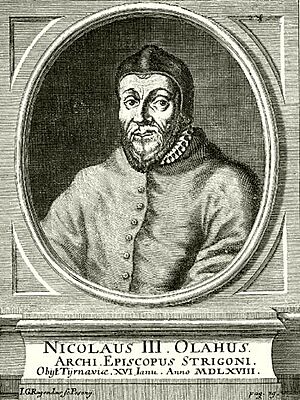Nicolaus Olahus facts for kids
Quick facts for kids His Excellency Nicolaus Olahus |
|
|---|---|
| Archbishop of Esztergom Primate of Hungary |
|
 |
|
| See | Esztergom |
| Appointed | 20 March 1553 |
| Reign ended | 14 January 1568 |
| Predecessor | George Martinuzzi |
| Successor | Antonio Veranzio |
| Other posts | Bishop of Eger |
| Personal details | |
| Born | 10 January 1493 Nagyszeben, Kingdom of Hungary (now Sibiu, Romania) |
| Died | 14 January 1568 (aged 75) Pozsony, Kingdom of Hungary (now Bratislava, Slovakia) |
| Parents | Stephanus Olahus Barbara Huszár |
| Signature |  |
| Coat of arms |  |
Nicolaus Olahus (born January 10, 1493 – died January 15, 1568) was a very important leader in the Catholic Church in Hungary. He was the Archbishop of Esztergom and the top church official, known as the Primate of Hungary. He was also a smart writer and a humanist, which means he loved learning and classical studies.
Contents
Early Life and Education
Nicolaus Olahus was born in a place called Nagyszeben, which is now Sibiu, Romania. His father, Stephen, was related to John Hunyadi, a powerful leader. His mother was Barbara Huszár. Nicolaus was also a cousin of King Matthias Corvinus.
He wrote about his own life and kept many letters. From 1505 to 1512, he studied at the Chapter School in Várad (now Oradea, Romania). After that, he worked as a page for King Ladislaus II.
Soon, he decided to become a priest. He was ordained, meaning he became a priest, around 1516 or 1518.
Early Career in the Church
Nicolaus worked as a secretary for George Szatmári, who was the Bishop of Pécs. During this time, he became a canon (a type of priest) in Pécs, and later in Esztergom. By 1522, he was made the Archdeacon of Komárom.
In 1526, he became a secretary for King Louis II. After a big battle called the battle of Mohács, Nicolaus joined the side of King Ferdinand I. He also continued to work for Queen Mary of Habsburg.
Becoming a High-Ranking Official
In 1527, Nicolaus Olahus became the head of the Chapter of Székesfehérvár. He traveled with Queen Mary to a big meeting called the Imperial Diet in Augsburg in 1530.
When Queen Mary became the Governor of the Netherlands in 1531, Nicolaus went with her. He stayed there until 1542. While in the Netherlands, he met a famous scholar named Erasmus, and they became friends who wrote letters to each other.
Rising Through the Ranks
When he returned to Hungary in 1542, King Ferdinand made him the Royal Chancellor (a high government official). He also became the Bishop of Agram (which is now Zagreb).
In 1548, he became the Bishop of Eger. Then, in 1553, he reached the highest church position in Hungary: Archbishop of Esztergom. As Archbishop, he had important duties, like crowning Maximilian as King of Hungary.
As Archbishop, Nicolaus worked hard to improve the finances of the church. He made sure the church received money from the mint in Körmöcbánya (now Kremnica, Slovakia). He also used his own money to get back church properties that had been given away as a guarantee for loans.
After the city of Esztergom was taken by the Ottomans, the Archbishop's main home moved to Nagyszombat or Pozsony.
Important Activities and Reforms
Nicolaus Olahus was very active in what was called the Counter-Reformation. This was a time when the Catholic Church worked to strengthen itself and respond to new ideas from the Protestant Reformation. He strongly disagreed with the new Protestant teachings.
As the Primate of Hungary, he worked hard to improve how the church was run. He wanted to make sure priests followed church rules and that new schools were started. He paid special attention to cities in Upper Hungary where Protestant ideas were spreading.
Improving the Church and Education
He visited many churches in his archdiocese himself to see what needed to be done. He also organized several church meetings called synods. The first big meeting was in 1560 in Nagyszombat. Here, he shared a set of rules for priests to follow.
In 1561, another important meeting was held to talk about Hungarian bishops joining the Council of Trent. This was a very important council for the Catholic Church. Nicolaus followed the council's discussions closely and put some of its decisions into practice in Hungary.
In 1563, Nicolaus sent a long letter to the council. In it, he explained the problems facing the Hungarian Church and how hard he was working to fix them. He believed that improving schools and educating young people was the best way to help the church.
He rebuilt the Cathedral school in Esztergom, which had been damaged when the Turks captured the city. He moved the school to Nagyszombat and put it in the care of the Jesuits. He invited the Jesuits to Hungary in 1561. The Jesuits were a religious group who helped teach and spread Catholic faith, and they had a big impact on the country.
Nicolaus also started the publication of important church books, like the Breviarium Ecclesiæ Strigoniensis (1558). He even brought back the tradition of ringing the Angelus bells. As a close advisor to King Ferdinand I, Nicolaus had a lot of political power. In 1562, he even served as a temporary ruler, known as a Regent. He was also a very busy writer.
Writings
Nicolaus Olahus wrote several important books and papers:
- Hungaria et Atila: This book was about the history of Hungary and its people, including the story of Attila the Hun.
- Genesis filiorum Regis Ferdinandi
- Ephemerides
- Brevis descriptio vitæ Benedicti Zerchsky
See also
- Melchior Cibinensis

